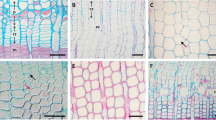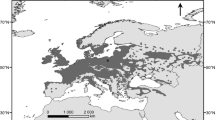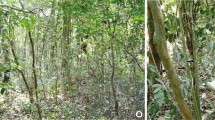Abstract
We investigated the structure and width of the dormant cambium and of the increments of phloem and xylem of Quercus robur to estimate their potential as indicators for tree vitality. The samples were taken from three woodlands, two in Slovenia [Krakovo forest (KRA) and Murska Suma (MUS)] and one in Croatia [Kobiljak (KOB)], with reported tree decline. The number of dormant cells seems to reflect the initial capacity of the cambium to accomplish cell division. With the exception of two trees at KRA, cell production was always higher on the xylem side than on the phloem side. The annual phloem increments were narrower, less variable among trees and with clear lower and upper limits. With increased cambial cell productivity, the share of the xylem in the total annual radial increment increased following a curvilinear function. In trees with an annual radial increment >3.5 mm, the xylem size represented more than 90 % of the total radial growth. The anatomical variables analyzed show that the most limiting environmental conditions seem to prevail at KRA, whereas the conditions at MUS seem to be most favorable in terms of radial growth. Analysis of the width and structure of xylem and phloem increments, the number of dormant cambial cells and their inter-relationships can provide additional information on the vitality of oaks.







Similar content being viewed by others
References
Alfieri FJ, Evert RF (1968) Seasonal development of the secondary phloem in Pinus. Am J Bot 55:518–528
Bauch J (1986) Characteristics and response of wood in declining trees from forests affected by pollution. IAWA Bull 7(4):269–276
Beck W (2009) Growth patterns of forest stands—the response towards pollutants and climatic impact. iFor J Biogeosci For 2:4–6
Bigler C, Bugmann H (2004) Assessing the performance of theoretical and empirical tree mortality models using tree-ring series of Norway spruce. Ecol Model 174:225–239
Bigler C, Gričar J, Bugmann H, Čufar K (2004) Growth patterns as indicators of impending tree death in silver fir. For Ecol Manag 199(2–3):183–190
Čater M, Kutnar L, Accetto M (2001) Slovenian lowland and floodplain forests. In: Klimo E, Hager H (eds) The floodplain forests in Europe: current situation and perspectives. Leiden, Boston, Köln, Brill, pp 233–248
Čavlović J (2010) Prva nacionalna inventura šuma u Republici Hrvatskoj. Zagreb
Dobbertin M (2005) Tree growth as indicator of tree vitality and tree reaction to environmental stress: a review. Eur J For Res 124(4):319–333
Evert RF (2006) Esau’s plant anatomy meristems, cells, and tissues of the plant body: their structure, function, and development. Wiley, Hoboken, NJ
Fink S (1986) Microscopical investigations on wood formation and function in diseased trees. IAWA Bull 7(4):351–355
Frantar P (2005) Pretočni režimi v Sloveniji med letoma 1971 in 2000. Geografski vestnik 77(2):115–127
Fromm J (2013) Xylem development in trees: from cambial divisions to mature wood cells. In: Fromm J (ed) Cellular aspects of wood formation. Springer, Berlin, pp 3–39
Gozdnogospodarski načrt gozdnogospodarske enote Krakovo 2006–2015 (Forest management plan for Forest Management Unit Krakovo 2006–2015). Brežice
Gregory RA (1971) Cambial activity in Alaskan white spruce. Am J Bot 58(2):160–171
Gregory RA, Wilson BF (1968) A comparison of cambial activity of white spruce in Alaska and New England. Can J Bot 46:733–734
Gričar J (2007) Xylo- and phloemogenesis in silver fir (Abies alba Mill.) and Norway spruce (Picea abies (L.) Karst.), vol 132. Studia Forestalia Slovenica, Slovenian Forestry Institute, Ljubljana
Gričar J, Čufar K (2008) Seasonal dynamics of phloem and xylem formation in silver fir and Norway spruce as affected by drought. Russ J Plant Physiol 55(4):538–543
Gričar J, Krže L, Čufar K (2009) Relationship among number of cells in xylem, phloem and dormant cambium in silver fir (Abies alba Mill.) trees of different vitality. IAWA Journal 30(2):121–133
Gričar J, de Luis M, Hafner P, Levanič T (2013) Anatomical characteristics and hydrologic signals in tree-rings of oaks (Quercus robur L.). Trees Struct Funct 27(6):1669–1680
Grosser D (1977) Die Hölzes Mitteleuropas. Springer, Berlin
Innes JL (1993) Methods to estimate forest health. Silva Fennica 27(2):145–157
Klimo E, Hager H (2001) Executive summary. In: Klimo E, Hager H (eds) The floodplain forests in Europe: current situation and perspectives. Brill, Leiden Boston Köln, p 7
Kozlowsky TT, Pallardy SG (1997) Growth control in woody plants. Academic Press Inc, San Diego, CA
Larson PR (1994) The vascular cambium: development and structure. Springer, Berlin
Levanič T, Čater M, McDowell NG (2011) Associations between growth, wood anatomy, carbon isotope discrimination and mortality in a Quercus robur forest. Tree Physiol 31:298–308
Oparka KJ, Robert T (1999) Sieve elements and companion cells—traffic control centers of the phloem. Plant Cell 11(4):739–750
Panshin AJ, de Zeeuw C (1980) Textbook of wood technology, 4th edn. McGraw-Hill, New York
Plomion C, Leprovost G, Stokes A (2001) Wood formation in trees. Plant Physiol 127(4):1513–1523
R Core Team (2012) R: a language and environment for statistical computing
Rao RV, Aebischer DP, Denne MP (1997) Latewood density in relation to wood fibre diameter, wall thickness, and fibre and vessel percentages in Quercus robur L. IAWA J 18:127–138
Schmitt U, Grünwald C, Gričar J, Koch G, Čufar K (2003) Wall structure of terminal latewood tracheids of healthy and declining silver fir trees in the Dinaric region, Slovenia. IAWA J 24(1):41–51
Schweingruber FH (1986) Abrupt growth changes in conifers. IAWA Bull 7(4):277–283
Siegel S, Castellan NJ (1988) Non parametric statistics for the behavioural sciences, 2nd edn. MacGraw Hill, New York
Skene DS (1972) The kinetics of tracheid development in Tsuga canadensis Carr. and its relation to tree vigour. Ann Bot 36:179–187
Taiz L, Zeiger E (2006) Plant physiology, 4th edn. Sinauer Associates, Sunderland, MA
Tikvić I, Zečić Ž, Ugarković D, Posarić D (2009) Damage of forest trees and quality of timber assortmets of pedunculate oak on Spačva Area. Šumarski list 5–6:237–248
Torelli N, Shortle WC, Čufar K, Ferlin F, Smith KT (1999) Detecting changes in tree health and productivity of silver fir in Slovenia. Eur J For Pathol 29(3):187–197
Tyree MT, Zimmermann MH (2010) Xylem structure and the ascent of sap, 2nd edn. Springer, Berlin
UN-ECE (2008) The condition of forests in Europe: 2006 executive report. Institute for World Forestry, Hamburg
Urbančič M, Simončič P, Smolej I (2000) Pedunculate oak stands in lowland regions of Slovenia—soil water conditions. Glasnik za šumske pokuse 37:215–227
Vaganov EA, Hughes MK, Shashkin AV (2006) Seasonal cambium activity and production of new xylem cells, vol Ecological Studies. Growth dynamics of conifer tree rings. Images of past and future environments, vol 183. Springer, Berlin. doi:10.1007/3-540-31298-6_3
van der Werf GW, Sass-Klaassen U, Mohren GMJ (2007) The impact of the 2003 summer drought on the intra-annual growth pattern of beech (Fagus sylvatica L.) and oak (Quercus robur L.) on a dry site in the Netherlands. Dendrochronologia 25:103–112
Wilson BF (1966) Mitotic activity in the cambial zone of Pinus strobus. Am J Bot 53:364–372
Zhang SY (1997) Variations and correlations of various ring width and ring density features in European oak: implications in dendroclimatology. Wood Sci Technol 31(1):63–72
Zweifel R, Eugster W, Etzold S, Dobbertin M, Buchmann N, Häsler R (2010) Link between continuous stem radius changes and net ecosystem productivity of a subalpine Norway spruce forest in the Swiss Alps. New Phytol 187:819–830
Acknowledgments
The authors would like to thank the anonymous reviewers for their valuable comments and suggestions to improve the quality of the paper. The work was supported by the Slovenian Research Agency, program P4-0107 and project Z4-9662 and by EUFORINNO (RegPot No. 315982) of the FP7 Infrastructures program. The cooperation among the international partners was supported by the COST Action FP1106, STREeSS.
Author information
Authors and Affiliations
Corresponding author
Additional information
Communicated by M. Meincken.
Rights and permissions
About this article
Cite this article
Gričar, J., Jagodic, Š., Šefc, B. et al. Can the structure of dormant cambium and the widths of phloem and xylem increments be used as indicators for tree vitality?. Eur J Forest Res 133, 551–562 (2014). https://doi.org/10.1007/s10342-014-0784-8
Received:
Revised:
Accepted:
Published:
Issue Date:
DOI: https://doi.org/10.1007/s10342-014-0784-8




